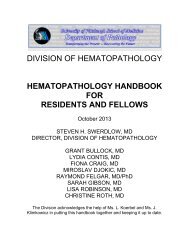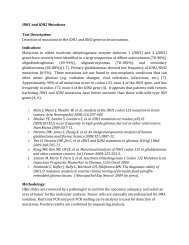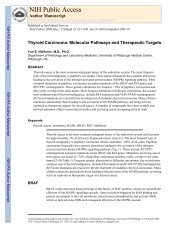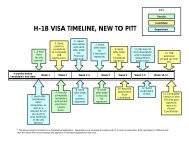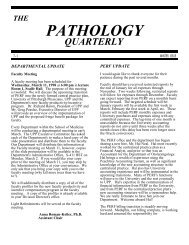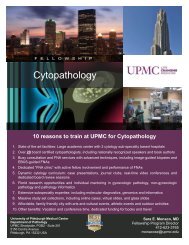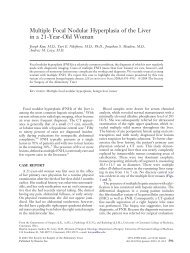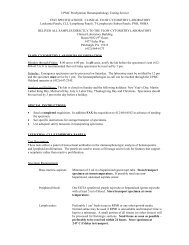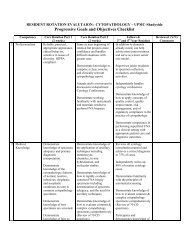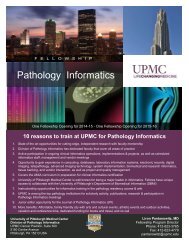Topological basis of signal integration in the transcriptional ...
Topological basis of signal integration in the transcriptional ...
Topological basis of signal integration in the transcriptional ...
You also want an ePaper? Increase the reach of your titles
YUMPU automatically turns print PDFs into web optimized ePapers that Google loves.
BMC Bio<strong>in</strong>formatics 2006, 7:478<br />
http://www.biomedcentral.com/1471-2105/7/478<br />
bound cell migration and cell extension), unknown<br />
biological_process, biological_process unknown,<br />
unknown), respectively.<br />
Task <strong><strong>in</strong>tegration</strong> by overlapp<strong>in</strong>g origons<br />
A simplify<strong>in</strong>g view <strong>of</strong> <strong>the</strong> TR network is provided by <strong>the</strong><br />
origon representation [13], shown by color-coded circles<br />
<strong>in</strong> Figure 1B. Each origon represents a cluster <strong>of</strong> nodes<br />
orig<strong>in</strong>at<strong>in</strong>g from a common (<strong>in</strong>put) TF (54 <strong>of</strong> <strong>the</strong>m <strong>in</strong> <strong>the</strong><br />
present case), and <strong>the</strong> color code <strong>the</strong>re<strong>in</strong> describes <strong>the</strong><br />
occurrence <strong>of</strong> four types <strong>of</strong> <strong>in</strong>teraction motifs dist<strong>in</strong>guished<br />
by <strong>the</strong>ir high Z-scores (see below). Except for <strong>the</strong><br />
two <strong>in</strong>put nodes mentioned above (Prd3 and Zap1), all<br />
origons are <strong>in</strong>terconnected due to <strong>the</strong> partial overlaps<br />
between <strong>the</strong>ir members at <strong>in</strong>termediate and output layers.<br />
The number <strong>of</strong> shared members is reflected by <strong>the</strong> thickness<br />
<strong>of</strong> <strong>the</strong> l<strong>in</strong>ks between <strong>the</strong> origons. The exam<strong>in</strong>ed yeast<br />
TR network has 418 such overlapp<strong>in</strong>g pairs <strong>of</strong> origons.<br />
Of <strong>in</strong>terest is to characterize <strong>the</strong> degree <strong>of</strong> <strong><strong>in</strong>tegration</strong> <strong>of</strong><br />
functional tasks between overlapp<strong>in</strong>g pairs <strong>of</strong> origons. To<br />
this aim, we first removed from <strong>the</strong> TR network all gene<br />
(products) with GO Slim annotation "unknown", and<br />
counted <strong>the</strong> number <strong>of</strong> genes annotated by a given GO<br />
Slim term, with<strong>in</strong> <strong>the</strong> subsets A^B (overlap), A\B and B\A<br />
(genes conta<strong>in</strong>ed only by A or B) for each pair <strong>of</strong> overlapp<strong>in</strong>g<br />
origons (A. B). Three vectors, def<strong>in</strong>ed by <strong>the</strong> fractions/probabilities<br />
<strong>of</strong> GO Slim terms were thus generated<br />
for each pair, denoted as a (for A\B), b (for B\A), or c (for<br />
A^B). The overlap (A^B) <strong>in</strong>tegrates tasks from <strong>the</strong> o<strong>the</strong>r<br />
two regions, if c is sufficiently similar to both a and b. The<br />
extent <strong>of</strong> similarity between <strong>the</strong> three probability distributions<br />
was <strong>the</strong>n assessed by <strong>the</strong> correlation cos<strong>in</strong>es (c·a)<br />
and (c·b), expressed by <strong>the</strong> sum K = c·(a+b), where <strong>the</strong><br />
dot designates <strong>the</strong> scalar product. We found that <strong>the</strong> K values<br />
for pairs <strong>of</strong> origons <strong>in</strong> <strong>the</strong> yeast TR network were significantly<br />
higher than those calculated for 100<br />
randomized test cases. The correspond<strong>in</strong>g Z score – i.e.<br />
(-)/ - averaged over all pairs<br />
was = 2.2.<br />
Locat<strong>in</strong>g densely connected subnetworks (organizers) <strong>of</strong><br />
Transcription Factors<br />
In <strong>the</strong> network <strong>of</strong> TFs (nodes: Transcription Factors, l<strong>in</strong>ks:<br />
regulatory <strong>in</strong>teractions) we identified subnetworks dist<strong>in</strong>guished<br />
by <strong>the</strong>ir dense <strong>in</strong>terconnection and central role<br />
(i.e., organizers) by us<strong>in</strong>g an iterative layer-peel<strong>in</strong>g algorithm<br />
[44], as follows. After first remov<strong>in</strong>g all autoregulatory<br />
loops, we repeatedly removed <strong>the</strong> nodes <strong>in</strong> <strong>the</strong> top<br />
and bottom layers <strong>of</strong> <strong>the</strong> network until only three small<br />
isolated (graph) components ('cores') rema<strong>in</strong>ed. To <strong>the</strong>se<br />
cores we <strong>the</strong>n added <strong>in</strong> 3 subsequent steps <strong>the</strong>ir up- and<br />
downstream <strong>in</strong>termediate regulators to obta<strong>in</strong> three<br />
major organizers (see Results). Alternatively, to locate<br />
overlapp<strong>in</strong>g, densely connected groups <strong>of</strong> nodes among<br />
<strong>the</strong> 69 non-isolated TFs we applied CF<strong>in</strong>der [45] to <strong>the</strong><br />
underly<strong>in</strong>g undirected network and identified <strong>the</strong> k-clique<br />
communities (groups <strong>of</strong> densely <strong>in</strong>terconnected nodes) at<br />
k = 3 correspond<strong>in</strong>g to 'roll<strong>in</strong>g' a triangle by mov<strong>in</strong>g one<br />
<strong>of</strong> its nodes at each step.. Note that any TF (node) was<br />
allowed to belong to more than one community. Next, we<br />
added to each community, C A , all nodes reachable from a<br />
node <strong>of</strong> C A via regulatory <strong>in</strong>teractions, but not yet conta<strong>in</strong>ed<br />
by any <strong>of</strong> <strong>the</strong> communities. Last, we merged communities<br />
C A and C B , if all exclusively conta<strong>in</strong>ed nodes <strong>of</strong><br />
C A were directly regulated by an exclusively conta<strong>in</strong>ed<br />
node <strong>of</strong> C B .<br />
Significance <strong>of</strong> <strong>the</strong> <strong>transcriptional</strong> response <strong>of</strong> a group <strong>of</strong><br />
genes<br />
Our goal was to quantify <strong>the</strong> effect <strong>of</strong> particular (environmental<br />
or <strong>in</strong>ternal) conditions (or <strong>signal</strong>s) S on <strong>the</strong> transcript<br />
levels <strong>of</strong> a selected group <strong>of</strong> genes. First, we grouped<br />
experiments (GSMs, Geo SaMples) accord<strong>in</strong>g to <strong>the</strong>ir platforms<br />
(GPLs). Then to each experiment obta<strong>in</strong>ed under a<br />
'normal' condition (e.g., stationary state) we assigned <strong>the</strong><br />
<strong>signal</strong> S = -1 and to all o<strong>the</strong>rs (e.g., hyper-osmotic shock,<br />
N depletion, or DNA damage with MMS) we assigned <strong>the</strong><br />
<strong>signal</strong> S = +1. Next, we computed <strong>the</strong> Pearson correlation,<br />
C i , between <strong>the</strong> ith gene's expression E ij and <strong>the</strong> jth experimental<br />
condition S j. us<strong>in</strong>g<br />
( ) =<br />
C E , S<br />
i ij j<br />
⎡<br />
⎣⎢<br />
where <strong>the</strong> subscript j <strong>in</strong>cludes both those experiments<br />
under <strong>the</strong> condition <strong>of</strong> <strong>in</strong>terest (i.e. experiments a 1 , a 2 , ...,<br />
a n , <strong>signal</strong> value: S j = +1) and those under 'normal' conditions<br />
(j = b 1 , b 2 , ..., b m , and S j = -1). The ith gene's response<br />
to <strong>signal</strong> S is significant, i.e., it is strongly activated<br />
(repressed), if its C i value is higher (lower) than <strong>the</strong> majority<br />
<strong>of</strong> <strong>the</strong> correlation values calculated for all yeast genes.<br />
This can be measured with <strong>the</strong> Z score, Z i = |C i - C|/ΔC, <strong>of</strong><br />
<strong>the</strong> ith gene's response, where C and ΔC are <strong>the</strong> average<br />
and standard deviation <strong>of</strong> <strong>the</strong> correlation values <strong>of</strong> all<br />
yeast genes. Here we use <strong>the</strong> absolute value, because a<br />
strong activation and a strong repression are equally<br />
important responses and should both give a high Z score.<br />
The significance <strong>of</strong> <strong>the</strong> response <strong>of</strong> <strong>the</strong> entire group G to<br />
condition S can be assessed by compar<strong>in</strong>g <strong>the</strong> average Z<br />
score <strong>in</strong> G, Z G = i∈G , to <strong>the</strong> similarly computed averages<br />
(Z H1 , Z H2 ,...) <strong>in</strong> o<strong>the</strong>r, randomly selected groups <strong>of</strong><br />
genes <strong>of</strong> <strong>the</strong> same size (H1, H2, ...). We used 1,000 such<br />
control groups. Denot<strong>in</strong>g by and ΔZ H <strong>the</strong> average<br />
and standard deviation <strong>of</strong> Z H values, <strong>the</strong> double Z score <strong>of</strong><br />
<strong>the</strong> response <strong>of</strong> group G is Y G = (Z G - )/ΔZ H .<br />
E<br />
⎤<br />
Eij<br />
− E ⎡ S<br />
j<br />
ij 1 −<br />
j ⎦⎥ ⎣⎢<br />
−<br />
ES ij j<br />
j<br />
ij<br />
j<br />
j<br />
/ /<br />
2 2 1 2 2 ⎤<br />
1 2<br />
j<br />
S<br />
⎦⎥<br />
,<br />
Page 10 <strong>of</strong> 12<br />
(page number not for citation purposes)



